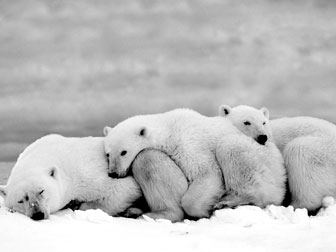Polar bear is a 'new' species
by Jonathan LEAKE
Polar bears may have come into existence only 150,000 years ago, when
trapped brown bears had to adapt to an ice age Polar bears may have come
into existence only 150,000 years ago, when brown bears were trapped by
an ice age and had to adapt quickly to survive, scientists have found.
The suggestion follows the discovery of the jawbone of an animal that
died up to 130,000 years ago, making it the oldest polar bear fossil
found.
The bone has yielded new insights into the origins of Earth's largest
land predator. One is the possibility that polar bears owe their
existence not only to past climate change, including ice ages, but have
also survived at least one long period of global warming.
The bone was discovered at Poolepynten on the Arctic island of
Svalbard by Professors Olafur Ingolfsson, of the University of Iceland,
and Oystein Wiig, of the University of Oslo.
In a research paper they concluded: "The Poolepynten subfossil
mandible, which we argue is from a fully grown male, is probably the
oldest polar bear find discovered so far. Its true age is interpreted to
be 110,000-130,000 years old."
 The bone has since been subjected to analyses that could help to
clear up the debate over when polar bears first appeared. Some academics
believe they evolved 50,000 years ago, while others put the date at more
than 1m years ago. The existence of the Svalbard fossil indicates that
polar bears were already a distinct species by about 130,000 years ago.
But anatomical and DNA evidence from the fossil indicate a closeness
between polar bears and brown bears of the time - suggesting the species
diverged no more than about 200,000 years ago and probably about 150,000
years ago. The bone has since been subjected to analyses that could help to
clear up the debate over when polar bears first appeared. Some academics
believe they evolved 50,000 years ago, while others put the date at more
than 1m years ago. The existence of the Svalbard fossil indicates that
polar bears were already a distinct species by about 130,000 years ago.
But anatomical and DNA evidence from the fossil indicate a closeness
between polar bears and brown bears of the time - suggesting the species
diverged no more than about 200,000 years ago and probably about 150,000
years ago.
This sharply narrows the "window" during which polar bears might have
emerged to a period when the northern hemisphere was being sucked into
an ice age that lasted from 190,000 to 130,000 years ago. This change of
climate would have pressurised brown bears, especially those trapped on
islands, to adapt to cold and ice. One research group, led by Gerald
Shields, of the University of Alaska Fairbanks, used DNA from 61 brown
bears taken from three populations in Alaska and 55 polar bears from
Arctic Canada and Siberia. The scientists wanted to work out not only
when polar bears evolved but also, potentially, where from.
They found a population of brown bears living on the Alaskan islands
of Admiralty, Baranof and Chichagof, known as the ABC islands, which lie
adjacent to each other. The DNA of those bears was closer to that of
polar bears than any other brown bear population.
In a paper they said: "Brown bears of the ABC islands may be
descendants of ancient ursids [bears] that diverged from other lineages
of brown bears and subsequently founded the polar bear lineage." This
view is expected to get support from new research, out this week, based
on DNA extracted from the Poolepynten jawbone.
It means polar bears have already survived a global warming that
affected the northern hemisphere from 130,000 to 115,000 years ago, when
the Greenland ice sheet and the Arctic ice cap were smaller than now.
Professor Chris Stringer, of the Natural History Museum in
London, an expert in ice ages, said: "Early polar bears would not
have had all the specialisations of modern animals and we know nothing
about their behaviour.
"Living through a warm period back then does not mean they are
resilient to climate change now."
- Timesonline.co.uk
|

